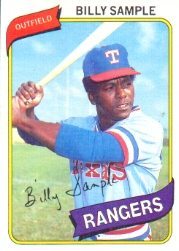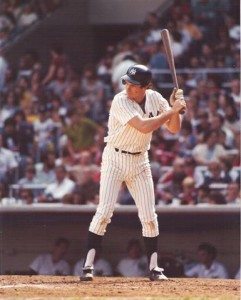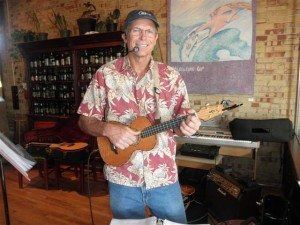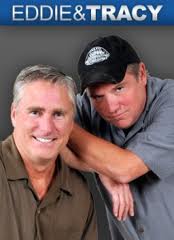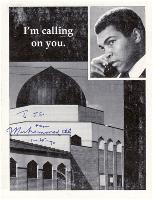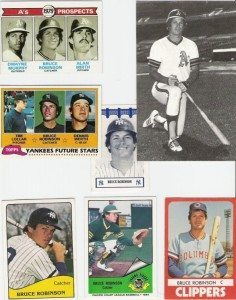 |
A grateful, talented Yankees fan wished Bruce a
happy birthday (April 16) in a
2011 post on www.myyesnetwork.com forum.
Check out Bruce’s website below for
more rare Yankees photos! |
Because he wore The Pinstripes, right?
That wasn’t the main reason I was interested in Bruce Robinson. Once I went to www.BruceRobinsonMusic.com, I saw a man who was living his dream A SECOND TIME!
Sure, he was Oakland’s first-round draft pick, He made the majors. However, he didn’t let his dreams die in the 1980s.
Bruce has hit the road with his guitar (and a ukulele?!?), singing his own songs. He has a debut CD available on his website. I hope you’ll check it out. He’ll autograph any copy you order!
I’m grateful that the catcher-turned-singer/songwriter took time to share some impressive memories. Here’s our conversation:
Q: I’ll start not with a question, but with thanks. You’ve signed autographs for years. We appreciate your kindness to fans.
A: Your are most welcome. It is always an honor and a privilege to sign my name as a former major leaguer!
Q: You were a first-round draft pick?
A: Yes, 21st pick in the 1975 June free agent draft, the 11th edition of the draft. I was the 1st position player from San Diego drafted in the first round since the inception of the draft. Two others, both pitchers, Steve Dunning (like me a high schooler who was a first round pick out of Stanford University) and Brien Bickerton.
Q: We see ESPN coverage of the NFL draft, which MLB has tried to match. Your thoughts?
A: Hard to do that in baseball because of the typical development time that is required to prepare a college or especially a high school player to be able to play in the major leagues. With basketball and football, it is very different as college players make immediate impacts in their sports. Also basketball and football severely restrict the number of rounds of the draft. Following a half dozen or so rounds, the remaining players are free agents. In baseball, often there are over 50 rounds of selections.
Q: How much excitement and ceremony was in your selection and actual signing as a first-rounder?
A: Not much, mostly just within the circle of friends family and teammates. That being said, being a first round selection is something that is a lifetime feather in one’s cap, much like a degree from Stanford, or playing in the major leagues. You are aware that only 5 percent of players that sign a professional contract actually end up in the major leagues, even if for only one day. I believe the statistic for 1st round choices is about 50 percent.
Q: During your playing career, who were some other players you found with real musical ability?
A: When I was playing, I didn’t know of any on my teams. Tim Flannery and Eric Show played guitar in the Padres organization. Show was an exceptional jazz musician. Flannery has nowhere near that kind of ability but he has done exceptionally well with his Jimmy Buffett style cover band and a few originals.
Q: And who knew about your aspirations in those years?
A: Guys I still communicate with remember me toting a guitar everywhere, but my aspirations were more geared toward pure enjoyment of playing other people’s music. Bernie Williams is a very nice jazz guitar player and I would imagine there are hundreds of others.
Q: The Robby Pad, your invention, is genius!
A: Thank you.
Q: When did the idea first come, and how long did it take to get from paper to finished product?
A: I came up with the idea in 1980 while playing with Columbus, AAA affiliate for the New York Yankees. Wilson Sporting Goods expressed considerable interest in the product and I have letters to back that up. They took photos and wanted to work with me, until they found out my patent search proved The Robby Pad was not patentable. (Sees there was some hinged product in the late 1800s, not even related to baseball, and that precluded my being awarded a patent).
When Wilson learned of that, they discontinued communication and stole the idea, saying (when I sued them), they had developed the idea first and were under no obligation to tell me that when they were wooing me and my Robby Pad.
Q: Was it hard to get listened to by companies, being “just” a player?
A: A good idea, just like a good player, will be found and developed.
Q: I’ve seen you on two Topps cards. Cool! What did you think of the cards then — and how do you feel today?
A: It was exciting to have my photo take for a Topps bubble gum card. They gave you a $5.00 check and still do today, I believe. I also signed with Louisville Slugger (I got a set of gold clubs with a pro style golf bag with my name emblazoned upon it) and with Wilson for gloves (three gloves per season).
Q: Your website is amazing, showing both of your careers. You’ve posted some great baseball pictures, too. The shot of you beside Mantle is awesome, two Yankees in uniform. What was a conversation like with The Mick?
A: That day we were talking about bunting, both sacrifice and drag. He never bunted from the right side, only left-handed and always drag bunted, taking the ball with him to the right of the pitcher (1st base side of the diamond).
He was very approachable, but was only around for a couple weeks during spring training.
*******
(Thanks again to talented collector and steadfast blog supporter Kohei Nirengi for his suggestion for this feature!)
Coming Friday:Bruce Robinson, part 2… Coaching minor leaguers Jose Canseco and Mark McGwire in 1984!
Like this:
Like Loading...
